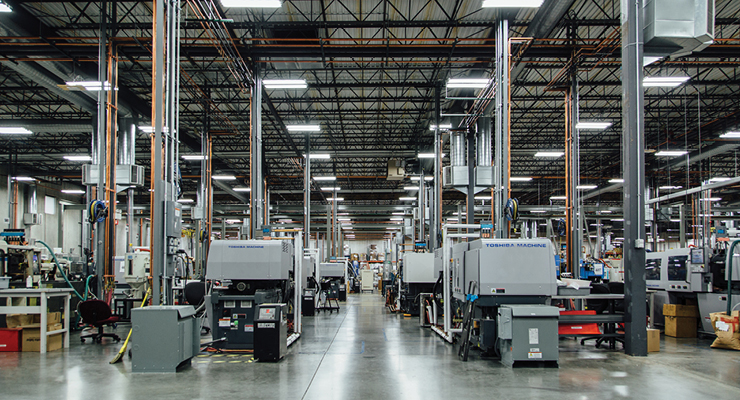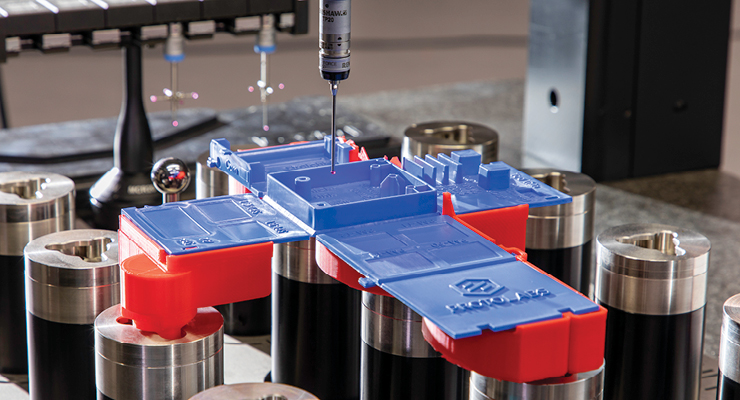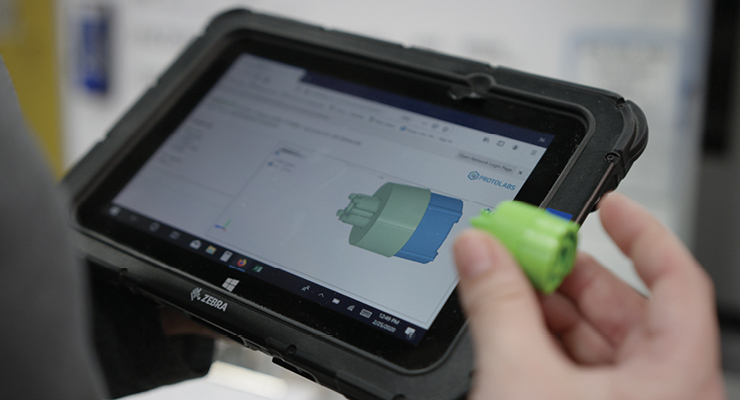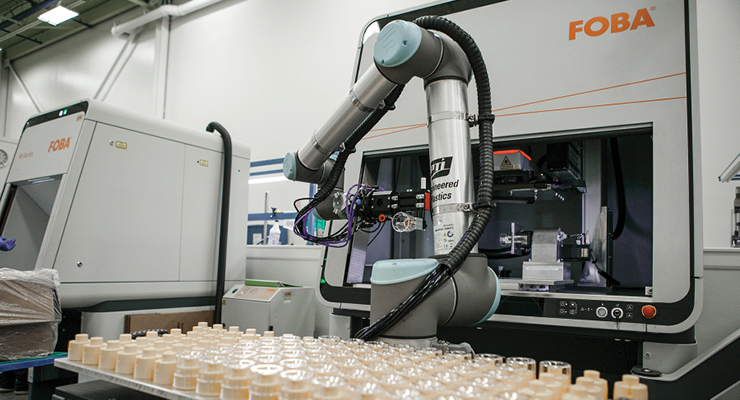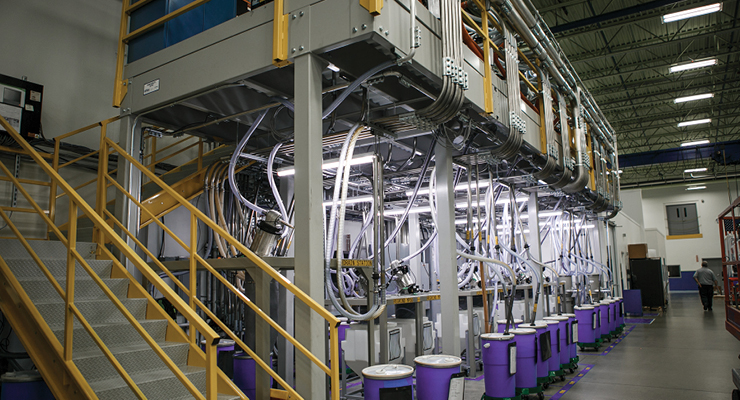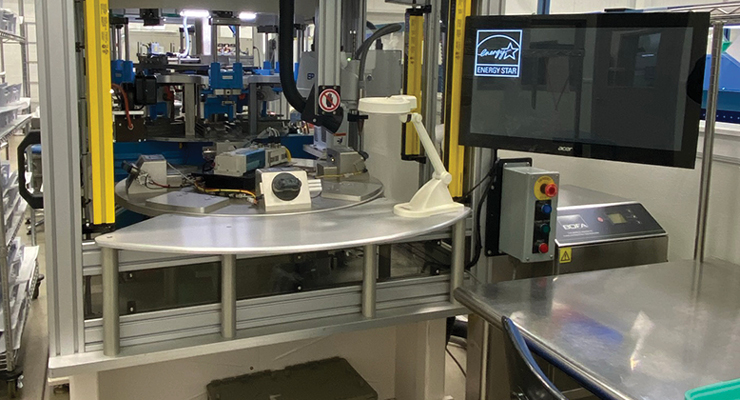Mark Crawford, Contributing Editor06.02.22
Molding processes for medical devices have always focused on consistency and control. As product designs become smaller and more complex, medical device manufacturers (MDMs) are pushing the limits of molding technologies, which in turn, is driving more innovation, tighter tolerances, and customized processes. Molding is also becoming more efficient through the Internet of Things (IoT)—for example, real-time monitoring of conditions inside mold cavities that records parameters for each cycle and can signal operators in real time with alarms or texts when even the slightest variances are detected.
“Molding equipment and tool manufacturers have upgraded their offerings to include the latest technologies and increased capabilities to keep pace with the voice of the customer,” said Mark Polinsky, president of Forum Plastics, a Waterbury, Conn.-based contract manufacturer that provides injection molding, insert molding, and overmolding services to the medical device and life science industries. “Molders have invested in their capital base, infrastructure, and facilities to keep pace with these increasing requirements. Additive manufacturing is also progressing rapidly and can be seen as a complementary or as a disruptive manufacturing technology.”
Because the aging U.S. population is more active than in past generations and living longer, the medical device industry continues to be a high-growth market for new procedures, treatments, therapies, and devices—for use both within and outside of hospitals and clinics. Sales for point-of-care devices for monitoring and treating health conditions at home are on the rise, driven by pandemic-induced remote telemedicine.
“Increasingly, we have been involved in many types of self-dosing and monitoring devices,” said John Budreau, director of new business for PTI Engineered Plastics, a full-service custom injection molder that serves the medical device industry. “Entry into this market for newcomers has also become more challenging with development and validation requirements.”
With ongoing supply chain issues, it can be very challenging to meet delivery schedules for both legacy products and new devices. These irregularities continue to vex MDMs, especially for their material needs—for example, silicone and rubber molders are impacted by the global shortage of the basic materials they need to manufacture silicone and organic rubber materials. “Lead times have at least doubled or more and, in some cases, under allocation or force majeure—and of course, prices have gone up significantly,” said Rey Obnamia, vice president of quality and regulatory for IRP Medical, a San Clemente, Calif.-based provider of custom engineering and elastomeric molding technologies for the medical device industry. “Couple this with the logistical issues of moving product from overseas to our seaports and land transport challenges, plus ongoing labor shortages, the supply chain is still a big problem for our industry.”
“Developing accurate, low-cost, disposable test kits for a greater range of illnesses or conditions could be the wave of the future,” said Wayne Daniels, director of business development for Canon Virginia, a Newport News, Va.-based custom manufacturer that provides manufacturing process development, molding, prototyping, and component and sub-assembly manufacturing. “With the increasing technology and capability of these devices, the requirement for very tight-tolerance parts is increasing, which of course requires high-precision tooling.”
For most projects, rapid prototyping is a “must have” for fast, problem-free production and speed to market. “Demand for rapid tooling development is strong,” said Jeff Randall, vice president and chief technical officer for MRPC, a Butler, Wis.-based full-service contract manufacturer of medical devices, instruments, and disposables. “While rapid prototyping has its place in the development cycle, reducing the timeline to produce parts using the production material of choice via the production process of choice is critical. The capabilities and cost-effectiveness of rapid tooling are improving on a daily basis.”
Rapid prototyping is, however, also impacted by supply chain disruptions. An increasing number of alternate technologies are available that can help support rapid prototyping, such as the growing options surrounding bridge or low-volume tooling, including 3D-printed (3DP) tools in a variety of material constructs that can withstand a range of processing conditions. “In conjunction with this, one can use a modular tooling system to allow for a multitude of insert configurations produced through conventional and/or new 3DP or AM means, so as to reduce longer lead times and higher cost considerations,” said Khristine Carroll, vice president of business development for Forum Plastics. “Also, new innovative technologies such as freeform injection molding can allow for parts to be prototyped using a wide range of medical-grade materials in a cost, time, and environmentally conscious manner while negating conventional tooling lead-times, costs, and the potential of tooling material constraints or delays.”
The increasing variety of materials that are suitable for prototyping provides alternative substances if first-choice materials are delayed or unavailable. Many commonly used materials in the medical industry have been supply constrained, which has caused product developers to pursue alternative options. “Sometimes this means alternative procurement strategies to secure as much of a given material as possible, such as increasing safety stocks, but it can also mean qualifying multiple materials for an application to create more agility,” said Rob Young, product marketing leader for injection molding for Proto Labs, a Maple Plain, Minn.-based digital manufacturer providing injection molding, computer numerical control (CNC) machining, 3D printing, and sheet metal fabrication services.
Precision-molded components and assemblies continue to get smaller with more micro features, thinner walls with long aspect ratios in challenging resins, and tighter tolerances of the molded parts and assemblies. For example, walls can be as thin as 50 microns with long fill lengths, including 400:1 ratios. Micro features can be as small as three microns and positional accuracies for assembly are typically within a few microns.
“Along with these intricate tooling and molding demands, metrology requirements have had to keep pace to make these measurements” said Brent Hahn, vice president of business development and strategy for Isometric Micro Molding, a New Richmond, Wis.-based provider of micro molding and automated assembly solutions for the medical device and drug delivery industries. “It doesn’t matter if you can mold and measure the part or assembly—you must also be able to validate it.”
Quality, accuracy, and validation can all be measured with CT scanning, which measures part features so small they are difficult to see with the naked eye, or are within the walls of molded parts and cannot be seen. Voids, sink marks, and other common molding defects can now be observed just by scanning the component and inspecting the results. “Additionally, using the ZEISS CT approach, a part never has to be destroyed to obtain any dimensions, which is often required with traditional coordinate measuring machine [CMM] applications,” said Robert Sinor, marketing manager for Trademark Plastics, a Riverside, Calif.-based provider of plastic injection molding for components for MDMs. “The ZEISS Metrotom 800 CT machine is able to achieve accuracy to the millionth in inches [0.000001 inches], whereas most traditional CMMs are accurate to the nearest ten thousandth in inches [0.0001 inches].”
As medical devices become smaller and more sophisticated, there is growing demand for micro-molding capabilities. This is especially true for the miniaturization of self-navigating medical devices that are small enough to move through blood vessels, smart implantable sensors, and smart wearable biosensors. “All of these require miniscule rubber components [0.09 inches or less] that demand exacting controls of the micro injection molding process, including raw material batch-to-batch consistency, ultra-small and repeatable shot size, advanced equipment/process monitoring, full automation that includes in-line vision product inspection and measurement, and specialized product handling through packaging,” said Obnamia. “It does not leave much margin for error—only about ±0.001 inches.”
Micro injection molding machines continue to innovate through improved process controls, embedded sensor technologies, and machine designs that add functionality and streamline changeovers. For example, more MDMs are interested in the micro injection molding of liquid silicone rubber (LSR). “ENGEL offers machines that can run LSR micro-molding and be converted to standard thermoplastic molding in less than 30 minutes,” said Jon Kelm, vice president of the medical and packaging business for ENGEL North America. ENGEL Global, manufacturer of plastic injection molding machines, is headquartered in Schwertberg Austria, with a North American headquarters in York, Pa. “This is good for customers that need to be flexible in their production.”
One way to shorten timelines is by adopting more agile or iterative development strategies. MDMs are being asked to develop technologies at record pace to respond to changing conditions—for example, pandemic-related products that can be used at home. Practices such as telehealth have become a norm due to COVID-19 precautions and have increased the urgency for new supporting technology. “Much of this technology is being developed faster than it historically would have, due to market demand,” said Young. “Medical diagnostics have seen a similar trend. These examples typically have compressed development cycles and product developers are searching for solutions to complete more iterations per cycle.”
OEMs or custom molders have very tight schedules for new tooling projects because the validation time, once they receive the tool, is so long. On-time delivery is critical to support speed to market. “As a result,” said Daniels, “improved molding efficiencies to meet the increased demand for consumables is what OEMs want most—for example, higher cavitation tooling, shorter cycle times, and development of other materials to meet the demand and also support sustainability.”
There are plenty of other items on the OEM wish list, including material/supply chain optimization, rapid scalability, and project transfer support. MDMs and their contract manufacturers (CMs) are also asking for smaller-footprint machines for medical device applications, including cleanroom procedures. Larger medical device companies often expect their tool shops to have thorough quality systems in place to verify how the tools are built. “Metrology backing is the biggest push, ensuring that everything that is produced matches with what is on the print,” said John Woodhouse, director of sales and marketing for Medbio, a Grand Rapids, Mich.-based full-service contract manufacturer for medical devices.
MDMs want partners they can completely trust that will work to meet all their development and production goals, in as few steps as possible, and at the lowest cost and highest quality, from design through production and regulatory approval—quickly.
Ultimately, medical customers are looking for suppliers that can add value to their organization, noted Randall.
“There is also a serious shortage of engineering talent, especially those with creativity,” he said. “Savvy OEMs are seeking partners with creativity and the ability to solve problems. Sometimes the most elegant solutions to complex problems are simple—but it takes creativity to see them.”
“Advancements in metal 3D printing allow for comprehensively customizable tooling options and components that are not feasible today through conventional machining equipment, in a more time and cost-conscious manner,” said Carroll. “3D-printed cavities and cores that allow conformal cooling and porous-steel sections for improved venting streamline the molding process and do not add significant cost or lead time.”
Isometric has added three high-resolution micro 3D printers to assist customers with early design and help evaluate multiple design options quickly, including printing in medical-grade photopolymers. “Improved ultra-fine resolution printing, coupled with parts in hand in less than a week, is a powerful advancement,” said Hahn. “For example, we have printed parts with the largest part dimension only 25 microns.” Isometric also helps MDMs with design for manufacturing and design for assembly early in the development phase so scalability can be reviewed, even at the prototype stage.
Canon has developed technology that improves the efficiency of parts with longer cycle times. On applications with cycle times that are at least 30 seconds or longer, the overall combined cycle can be greatly reduced with the “shuttle mold system” increasing productivity. Two molds are run simultaneously on a single machine and, depending on cycle time, can up to double the productivity. After resin is injected into the first mold, it shuttles the second mold into position, capitalizing on the cooling time outside of the machine and increasing efficiency. “This system can be used to mold two identical parts or two different parts, as well as also use multi-cavity molds,” said Daniels.
Vision systems are essential for quality control. In 2021, Proto Labs released an automated CMM technology to verify critical dimensions on a part during manufacturing, saving time and cost in transition from development to market. Product developers can leverage this technology to gain critical insights in performance and reliability, which, when applied, can reduce time to market and time to revenue. “This year, we have iterated on this technology to include geometric dimensioning and tolerancing as an added layer of verification and transparency,” said Young.
“We are seeing constant requests for ways to make machines ‘smarter’ and optimize their performance, with less operator input,” added Kelm. “There is also considerable interest in predictive maintenance for the machines so downtime can be planned rather than unexpected. ENGEL’s iQ suite of digital, self-regulating products increase process stability and repeatability.” For example, iQ Flow Control automatically ensures consistent and efficient temperature control processes and makes real-time adjustments for process variations.
iMFLUX is an adaptive process technology software owned by Procter & Gamble for plastic injection molding machines. This technology improves the efficiency of injection molding processes through closed-loop feedback that maintains low constant pressure and automatically adjusts for viscosity and environmental variations. iMFLUX fills the mold at a slower rate so the material actually cools, densifies, and packs as it fills.
“iMFLUX maintains constant pressures throughout the injection molding process and can even continue those pressures through material and color changes,” said Sinor. “This significantly increases uptime, improves quality, decreases energy consumption, and allows for adaptability within processing. Having an autonomously stable process frees up several hours per day for each process engineer in our facility, allowing them to focus on more intricate projects.”
Also, with the addition of more complex auxiliary equipment, comes the demand for turnkey interfaces, noted Woodhouse. “Many mold machine manufacturers now have options ready to go for ease of setup when it comes to launching new programs,” he said. “There is also an increasing number of monitoring software solutions that offer more integration. These may be in the form of supervisory control and data acquisition (SCADA) systems, molding machine process monitoring, or auxiliary equipment software that monitors all crucial equipment parameters.”
Validation and accreditation are increasingly important in the medical device industry, not just for speeding up the regulatory process but also to reflect deep expertise and commitment to quality manufacturing. For example, MedAccred, a medical device industry-managed supply chain oversight program managed by the Performance Review Institute, is gaining momentum among MDMs and CMs. MedAccred’s goal is to reduce patient risk by verifying compliance with critical manufacturing processes to ensure the quality and consistency of medical devices.
MRPC is actively pursuing MedAccred certification within the next few months. “Unlike ISO 13485, MedAccred is an accreditation that delves deeply into manufacturing processes,” said Randall. “ISO 13485 is a broad assessment of a company’s procedures and practices, seeking consistency throughout the organization and encompassing every department. MedAccred focuses on the manufacturing processes themselves including molding process development, process control, and practices in maintaining equipment.”
MedAccred status improves supply chain and manufacturing efficiency and product quality, and reduces the potential for defects, recalls, and litigation/liability exposure.
Molding innovation is also driven by digitalization through software advances, digital twins and other simulation or modeling technologies, and IoT. “Along the entire product lifecycle—from part design and mold sampling to production and maintenance and service—digital solutions enable significant improvements in process quality, reduced wear, and higher-quality parts in injection molding production,” said Kelm.
Artificial intelligence (AI) promises to be the next big disruptive technology. With big tech/big data already intensively using it in their core businesses, AI will make molding processes faster and smarter, with continual improvement and less guesswork. “Imagine a predictive molding process providing real-time information about material flow, cavity fill, stress zones/heatmap, shrinkage map, or intelligent molding machines that can automatically optimize or adjust process settings to correct part and process variations in real time with high speed data acquisition,” said Obnamia.
New complementary technologies, manufacturing automation, and innovative materials and/or additives continue to take molding processes to next-generation levels.
However, molding solutions do not have to be complex or expensive.
“There are often many ways to achieve the part function with small changes or with secondary operations,” said Polinsky. “It’s important for designers and molders to communicate early in the process and take advantage of each other’s knowledge to produce the best design and part.”
Mark Crawford is a full-time freelance business and marketing/communications writer based in Madison, Wis. His clients range from startups to global manufacturing leaders. He also writes a variety of feature articles for regional and national publications and is the author of five books.
“Molding equipment and tool manufacturers have upgraded their offerings to include the latest technologies and increased capabilities to keep pace with the voice of the customer,” said Mark Polinsky, president of Forum Plastics, a Waterbury, Conn.-based contract manufacturer that provides injection molding, insert molding, and overmolding services to the medical device and life science industries. “Molders have invested in their capital base, infrastructure, and facilities to keep pace with these increasing requirements. Additive manufacturing is also progressing rapidly and can be seen as a complementary or as a disruptive manufacturing technology.”
Because the aging U.S. population is more active than in past generations and living longer, the medical device industry continues to be a high-growth market for new procedures, treatments, therapies, and devices—for use both within and outside of hospitals and clinics. Sales for point-of-care devices for monitoring and treating health conditions at home are on the rise, driven by pandemic-induced remote telemedicine.
“Increasingly, we have been involved in many types of self-dosing and monitoring devices,” said John Budreau, director of new business for PTI Engineered Plastics, a full-service custom injection molder that serves the medical device industry. “Entry into this market for newcomers has also become more challenging with development and validation requirements.”
With ongoing supply chain issues, it can be very challenging to meet delivery schedules for both legacy products and new devices. These irregularities continue to vex MDMs, especially for their material needs—for example, silicone and rubber molders are impacted by the global shortage of the basic materials they need to manufacture silicone and organic rubber materials. “Lead times have at least doubled or more and, in some cases, under allocation or force majeure—and of course, prices have gone up significantly,” said Rey Obnamia, vice president of quality and regulatory for IRP Medical, a San Clemente, Calif.-based provider of custom engineering and elastomeric molding technologies for the medical device industry. “Couple this with the logistical issues of moving product from overseas to our seaports and land transport challenges, plus ongoing labor shortages, the supply chain is still a big problem for our industry.”
Latest Molding Trends
Molding capabilities must adapt to keep pace with medical device trends, especially for smaller and smarter products, such as devices that provide rapid results at the point of use, rather than shipping a sample to a lab, such as at-home testing. Molding must also stay competitive with other production technologies, including additive manufacturing (AM).“Developing accurate, low-cost, disposable test kits for a greater range of illnesses or conditions could be the wave of the future,” said Wayne Daniels, director of business development for Canon Virginia, a Newport News, Va.-based custom manufacturer that provides manufacturing process development, molding, prototyping, and component and sub-assembly manufacturing. “With the increasing technology and capability of these devices, the requirement for very tight-tolerance parts is increasing, which of course requires high-precision tooling.”
For most projects, rapid prototyping is a “must have” for fast, problem-free production and speed to market. “Demand for rapid tooling development is strong,” said Jeff Randall, vice president and chief technical officer for MRPC, a Butler, Wis.-based full-service contract manufacturer of medical devices, instruments, and disposables. “While rapid prototyping has its place in the development cycle, reducing the timeline to produce parts using the production material of choice via the production process of choice is critical. The capabilities and cost-effectiveness of rapid tooling are improving on a daily basis.”
Rapid prototyping is, however, also impacted by supply chain disruptions. An increasing number of alternate technologies are available that can help support rapid prototyping, such as the growing options surrounding bridge or low-volume tooling, including 3D-printed (3DP) tools in a variety of material constructs that can withstand a range of processing conditions. “In conjunction with this, one can use a modular tooling system to allow for a multitude of insert configurations produced through conventional and/or new 3DP or AM means, so as to reduce longer lead times and higher cost considerations,” said Khristine Carroll, vice president of business development for Forum Plastics. “Also, new innovative technologies such as freeform injection molding can allow for parts to be prototyped using a wide range of medical-grade materials in a cost, time, and environmentally conscious manner while negating conventional tooling lead-times, costs, and the potential of tooling material constraints or delays.”
The increasing variety of materials that are suitable for prototyping provides alternative substances if first-choice materials are delayed or unavailable. Many commonly used materials in the medical industry have been supply constrained, which has caused product developers to pursue alternative options. “Sometimes this means alternative procurement strategies to secure as much of a given material as possible, such as increasing safety stocks, but it can also mean qualifying multiple materials for an application to create more agility,” said Rob Young, product marketing leader for injection molding for Proto Labs, a Maple Plain, Minn.-based digital manufacturer providing injection molding, computer numerical control (CNC) machining, 3D printing, and sheet metal fabrication services.
Precision-molded components and assemblies continue to get smaller with more micro features, thinner walls with long aspect ratios in challenging resins, and tighter tolerances of the molded parts and assemblies. For example, walls can be as thin as 50 microns with long fill lengths, including 400:1 ratios. Micro features can be as small as three microns and positional accuracies for assembly are typically within a few microns.
“Along with these intricate tooling and molding demands, metrology requirements have had to keep pace to make these measurements” said Brent Hahn, vice president of business development and strategy for Isometric Micro Molding, a New Richmond, Wis.-based provider of micro molding and automated assembly solutions for the medical device and drug delivery industries. “It doesn’t matter if you can mold and measure the part or assembly—you must also be able to validate it.”
Quality, accuracy, and validation can all be measured with CT scanning, which measures part features so small they are difficult to see with the naked eye, or are within the walls of molded parts and cannot be seen. Voids, sink marks, and other common molding defects can now be observed just by scanning the component and inspecting the results. “Additionally, using the ZEISS CT approach, a part never has to be destroyed to obtain any dimensions, which is often required with traditional coordinate measuring machine [CMM] applications,” said Robert Sinor, marketing manager for Trademark Plastics, a Riverside, Calif.-based provider of plastic injection molding for components for MDMs. “The ZEISS Metrotom 800 CT machine is able to achieve accuracy to the millionth in inches [0.000001 inches], whereas most traditional CMMs are accurate to the nearest ten thousandth in inches [0.0001 inches].”
As medical devices become smaller and more sophisticated, there is growing demand for micro-molding capabilities. This is especially true for the miniaturization of self-navigating medical devices that are small enough to move through blood vessels, smart implantable sensors, and smart wearable biosensors. “All of these require miniscule rubber components [0.09 inches or less] that demand exacting controls of the micro injection molding process, including raw material batch-to-batch consistency, ultra-small and repeatable shot size, advanced equipment/process monitoring, full automation that includes in-line vision product inspection and measurement, and specialized product handling through packaging,” said Obnamia. “It does not leave much margin for error—only about ±0.001 inches.”
Micro injection molding machines continue to innovate through improved process controls, embedded sensor technologies, and machine designs that add functionality and streamline changeovers. For example, more MDMs are interested in the micro injection molding of liquid silicone rubber (LSR). “ENGEL offers machines that can run LSR micro-molding and be converted to standard thermoplastic molding in less than 30 minutes,” said Jon Kelm, vice president of the medical and packaging business for ENGEL North America. ENGEL Global, manufacturer of plastic injection molding machines, is headquartered in Schwertberg Austria, with a North American headquarters in York, Pa. “This is good for customers that need to be flexible in their production.”
What OEMs Want
OEMs still demand quality, reliability, and cost controls—these are absolute requirements. “We often hear that OEMs need to move faster to achieve the rate of innovation they need to meet market demand for their products,” said Young.One way to shorten timelines is by adopting more agile or iterative development strategies. MDMs are being asked to develop technologies at record pace to respond to changing conditions—for example, pandemic-related products that can be used at home. Practices such as telehealth have become a norm due to COVID-19 precautions and have increased the urgency for new supporting technology. “Much of this technology is being developed faster than it historically would have, due to market demand,” said Young. “Medical diagnostics have seen a similar trend. These examples typically have compressed development cycles and product developers are searching for solutions to complete more iterations per cycle.”
OEMs or custom molders have very tight schedules for new tooling projects because the validation time, once they receive the tool, is so long. On-time delivery is critical to support speed to market. “As a result,” said Daniels, “improved molding efficiencies to meet the increased demand for consumables is what OEMs want most—for example, higher cavitation tooling, shorter cycle times, and development of other materials to meet the demand and also support sustainability.”
There are plenty of other items on the OEM wish list, including material/supply chain optimization, rapid scalability, and project transfer support. MDMs and their contract manufacturers (CMs) are also asking for smaller-footprint machines for medical device applications, including cleanroom procedures. Larger medical device companies often expect their tool shops to have thorough quality systems in place to verify how the tools are built. “Metrology backing is the biggest push, ensuring that everything that is produced matches with what is on the print,” said John Woodhouse, director of sales and marketing for Medbio, a Grand Rapids, Mich.-based full-service contract manufacturer for medical devices.
MDMs want partners they can completely trust that will work to meet all their development and production goals, in as few steps as possible, and at the lowest cost and highest quality, from design through production and regulatory approval—quickly.
Ultimately, medical customers are looking for suppliers that can add value to their organization, noted Randall.
“There is also a serious shortage of engineering talent, especially those with creativity,” he said. “Savvy OEMs are seeking partners with creativity and the ability to solve problems. Sometimes the most elegant solutions to complex problems are simple—but it takes creativity to see them.”
New Tools and Technologies
Mold and tooling manufacturing continues to advance at an ever-increasing pace. From high-precision, high-spindle-speed machining centers to the additive manufacturing of mold components, innovative improvements include vision systems, laser machining, and advanced joining processes. Enhanced robotic technologies can provide fully integrated in-line inspection and part segregation. IoT and increased machine connectivity enable higher degrees of process control and defect reduction, which, in turn, reduce development cycle times.“Advancements in metal 3D printing allow for comprehensively customizable tooling options and components that are not feasible today through conventional machining equipment, in a more time and cost-conscious manner,” said Carroll. “3D-printed cavities and cores that allow conformal cooling and porous-steel sections for improved venting streamline the molding process and do not add significant cost or lead time.”
Isometric has added three high-resolution micro 3D printers to assist customers with early design and help evaluate multiple design options quickly, including printing in medical-grade photopolymers. “Improved ultra-fine resolution printing, coupled with parts in hand in less than a week, is a powerful advancement,” said Hahn. “For example, we have printed parts with the largest part dimension only 25 microns.” Isometric also helps MDMs with design for manufacturing and design for assembly early in the development phase so scalability can be reviewed, even at the prototype stage.
Canon has developed technology that improves the efficiency of parts with longer cycle times. On applications with cycle times that are at least 30 seconds or longer, the overall combined cycle can be greatly reduced with the “shuttle mold system” increasing productivity. Two molds are run simultaneously on a single machine and, depending on cycle time, can up to double the productivity. After resin is injected into the first mold, it shuttles the second mold into position, capitalizing on the cooling time outside of the machine and increasing efficiency. “This system can be used to mold two identical parts or two different parts, as well as also use multi-cavity molds,” said Daniels.
Vision systems are essential for quality control. In 2021, Proto Labs released an automated CMM technology to verify critical dimensions on a part during manufacturing, saving time and cost in transition from development to market. Product developers can leverage this technology to gain critical insights in performance and reliability, which, when applied, can reduce time to market and time to revenue. “This year, we have iterated on this technology to include geometric dimensioning and tolerancing as an added layer of verification and transparency,” said Young.
“We are seeing constant requests for ways to make machines ‘smarter’ and optimize their performance, with less operator input,” added Kelm. “There is also considerable interest in predictive maintenance for the machines so downtime can be planned rather than unexpected. ENGEL’s iQ suite of digital, self-regulating products increase process stability and repeatability.” For example, iQ Flow Control automatically ensures consistent and efficient temperature control processes and makes real-time adjustments for process variations.
iMFLUX is an adaptive process technology software owned by Procter & Gamble for plastic injection molding machines. This technology improves the efficiency of injection molding processes through closed-loop feedback that maintains low constant pressure and automatically adjusts for viscosity and environmental variations. iMFLUX fills the mold at a slower rate so the material actually cools, densifies, and packs as it fills.
“iMFLUX maintains constant pressures throughout the injection molding process and can even continue those pressures through material and color changes,” said Sinor. “This significantly increases uptime, improves quality, decreases energy consumption, and allows for adaptability within processing. Having an autonomously stable process frees up several hours per day for each process engineer in our facility, allowing them to focus on more intricate projects.”
Also, with the addition of more complex auxiliary equipment, comes the demand for turnkey interfaces, noted Woodhouse. “Many mold machine manufacturers now have options ready to go for ease of setup when it comes to launching new programs,” he said. “There is also an increasing number of monitoring software solutions that offer more integration. These may be in the form of supervisory control and data acquisition (SCADA) systems, molding machine process monitoring, or auxiliary equipment software that monitors all crucial equipment parameters.”
Validation and accreditation are increasingly important in the medical device industry, not just for speeding up the regulatory process but also to reflect deep expertise and commitment to quality manufacturing. For example, MedAccred, a medical device industry-managed supply chain oversight program managed by the Performance Review Institute, is gaining momentum among MDMs and CMs. MedAccred’s goal is to reduce patient risk by verifying compliance with critical manufacturing processes to ensure the quality and consistency of medical devices.
MRPC is actively pursuing MedAccred certification within the next few months. “Unlike ISO 13485, MedAccred is an accreditation that delves deeply into manufacturing processes,” said Randall. “ISO 13485 is a broad assessment of a company’s procedures and practices, seeking consistency throughout the organization and encompassing every department. MedAccred focuses on the manufacturing processes themselves including molding process development, process control, and practices in maintaining equipment.”
MedAccred status improves supply chain and manufacturing efficiency and product quality, and reduces the potential for defects, recalls, and litigation/liability exposure.
Moving Forward
Opportunities for molding innovation exist on many fronts. Metal parts can be converted to quality plastic parts, with the same or greater strength, durability, heat, and chemical resistance, at much less cost. Freeform injection molding technology provides rapid prototyping and low-volume options using medical-grade materials, supporting early-stage design, material, and process optimization. Micro surface finishes that incorporate biomimicry of hydrophobic and hydrophilic surfaces are additional advancements in surface functionality that can be incorporated into micro molding solutions.Molding innovation is also driven by digitalization through software advances, digital twins and other simulation or modeling technologies, and IoT. “Along the entire product lifecycle—from part design and mold sampling to production and maintenance and service—digital solutions enable significant improvements in process quality, reduced wear, and higher-quality parts in injection molding production,” said Kelm.
Artificial intelligence (AI) promises to be the next big disruptive technology. With big tech/big data already intensively using it in their core businesses, AI will make molding processes faster and smarter, with continual improvement and less guesswork. “Imagine a predictive molding process providing real-time information about material flow, cavity fill, stress zones/heatmap, shrinkage map, or intelligent molding machines that can automatically optimize or adjust process settings to correct part and process variations in real time with high speed data acquisition,” said Obnamia.
New complementary technologies, manufacturing automation, and innovative materials and/or additives continue to take molding processes to next-generation levels.
However, molding solutions do not have to be complex or expensive.
“There are often many ways to achieve the part function with small changes or with secondary operations,” said Polinsky. “It’s important for designers and molders to communicate early in the process and take advantage of each other’s knowledge to produce the best design and part.”
Mark Crawford is a full-time freelance business and marketing/communications writer based in Madison, Wis. His clients range from startups to global manufacturing leaders. He also writes a variety of feature articles for regional and national publications and is the author of five books.


